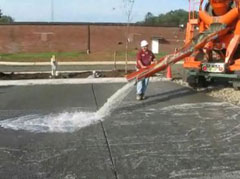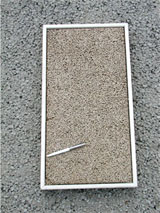
Pervious concrete pavement is a permeable pavement used to satisfy the need for both a pavement surface and stormwater management. Pervious concrete is created with narrowly graded coarse aggregate that is coated in a thin layer of cement paste or mortar. This allows for an interconnected pore structure through which water percolates. In addition to designing for hydrology (see
Hydrologic Design of Pervious Concrete), pervious concrete is structurally designed using normal design methods for pavements. The final key aspect to designing a pervious concrete pavement takes the durability into consideration.
Concrete durability is the ability to resist weathering action, chemical attack, and abrasion while maintaining desired engineering properties for the expected service life of the structure. Pervious concrete can become clogged, which directly affects the hydrologic performance and may indirectly affect other aspects of durability, such as freeze-thaw resistance, deicer salt scaling resistance, and sulfate resistance. Abrasion resistance of pervious concrete is also of concern, particularly in locations that use snow plows or have turning traffic. Carbonation and corrosion resistance are not concerns with pervious concrete as it is neither recommended nor necessary to use reinforcing steel bars or welded wire reinforcement.
Clogging

As stated earlier, pervious concrete is used for stormwater management. Water that flows onto the pavement flows through the pavement in an open-graded aggregate base. From there, the water either infiltrates into the subgrade or enters a conventional stormwater system. Any material that is picked up by the flowing water will also be taken into the concrete. The behavior of particles within the system depends on the pore system, particle size, nature of the particles, and the flow rate. Mata (2008) found that sand particles are trapped near the surface of the pavement, but that smaller sized particles (silts and clays) are flushed through to the bottom of the system. Haselbach (2010) studied the effects of different types of clay and found that more expansive clays, such as bentonite, will also collect near the surface. It was also found that the clogging potential of the clays reduced drastically when the porosity of the concrete was raised from near 30 percent (typical maximum) to near 40 percent.
Sediments that collect inside the concrete can significantly reduce infiltration rates and increase the opportunity for the cement matrix to become saturated by trapping water within the concrete pore system. This may cause an increased risk for freeze-thaw damage, deicer scaling, or sulfate attack. Sediments that are trapped near the surface can be mostly extracted by vacuuming.
Sediments that pass completely through the system cannot be extracted. Over time, these sediments will collect in the aggregate base and reduce the storage capacity and exfiltration rate. Knowledge of the surrounding soils is necessary for designing a pervious concrete pavement system and that knowledge can be used to avoid or mitigate infiltration of silts and clays. Barrier ribbons can be used to block soils from entering the sides of the pavement. Options available for dealing with low exfiltration or expansive soils (Tennis, Leming, and Akers 2004) may also help mitigate the effects of silty or clayey storm water.
Freeze-Thaw Resistance
The use of pervious concrete as a pavement began in warm climates where freeze-thaw damage was not a concern. Over time, use of pervious concrete pavements has moved into climates with increasingly severe freeze-thaw climates. This has raised significant concern among many groups, because of the high porosity of the concrete. See
Pervious Concrete and Freeze-Thaw for a full review of the freeze-thaw and deicer scaling durability of pervious concrete pavements.
Sulfate Resistance
The presence of an open-graded aggregate base beneath a pervious concrete pavement is the best method to mitigate sulfate attack from high-sulfate soils and groundwaters. Additional isolation may be required along the edges of the pavement in the form of a barrier ribbon. The typical water-cementitious materials ratios used in pervious concrete fall between 0.27 and 0.34, which is well below the recommended maximum of 0.40 for very severe sulfate exposure. If additional protection is needed due to a high clogging potential, sulfate resistant cement (ASTM C150 Types I and V, C595 designated MS and HS, or C1157 Types MS and HS) should be used.
Abrasion Resistance
Abrasion resistance of pervious concrete can be seen by observing how much and how quickly the surface aggregate particles ravel. This is of particular concern in locations with turning traffic or locations that use snow plows. The low w/cm and high porosity give pervious concrete an increased risk of surface drying before curing. If the surface dries out before developing strength, significant raveling will occur. This places a very high importance on streamlining the production process and ensuring the concrete is minimally exposed to ambient conditions. Research done by Dong and others (2010) shows that smaller aggregate sizes and the use of polypropylene fibers and latex can increase abrasion resistance as tested by ASTM C944,
Standard Test Method for Abrasion Resistance of Concrete or Mortar Surfaces by the Rotating-Cutter Method (Figure 1).
References
Dong, Qiao; Wu, Hao; Huang, Baoshan; and Shu, Xiang,
Development of a Simple and Fast Test Method for Measuring the Durability of Portland Cement Pervious Concrete, SN3149, Portland Cement Association, Skokie, Illinois, USA, 2010, 27 pages.
Haselbach, Liv M., “Potential for Clay Clogging of Pervious Concrete under Extreme Conditions,”
Journal of Hydrologic Engineering, Vol. 15, No. 1, January 2010, pages 67 to 69.
Mata, Luis Alexander, S
edimentation of Pervious Concrete Pavement Systems, PhD Dissertation, North Carolina State University, Raleigh, North Carolina, 2008.
Tennis, Paul, D.; Leming, Michael, L.; and Akers, David, J.,
Pervious Concrete Pavements, EB302, Portland Cement Association, Skokie, Illinois, and National Ready Mixed Concrete Association, Silver Spring, Maryland, USA, 2004, 36 pages.